Thomond -
Thomond no.4
Thomond no.4
Dick Humphreys' car,
Thomond no.2 (registration number ZI 2100),
was officially scrapped
on 17 Feb 1933,
apparently after a heavy crash and damage.
However, from at least as early as around Easter 1933 (April 1933),
a much different-looking Thomond
appears in the Humphreys family photographs. The bodywork is different,
and there is a new number plate, but underneath you can still see
that much of the old machine remains.
This is clearly a total re-build of Thomond no.2 into a new car,
Thomond no.4.
It seems clear that
Dick kept the chassis and most of the mechanicals,
but built a new body (taking the opportunity to implement some of his many new ideas).
The engine was scrapped
(probably because of the crash).
A new number plate was needed, since this was essentially a new car.
Work on the new car progressed fast.
The speed with which the new car appears after Feb 1933
suggests that work on it must have been in progress
before the date it was officially registered as scrapped.
[Motor Reg]
records the registration of the new car in 1933.
Gives date of manufacture as 1933.
New number plate ZI 9722.
The new Thomond turns up in family photos
before Dick left Sandymount
in Aug 1933.
It turns up in one photo which is dated
around Easter 1933 (April 1933).
The number plate shows it was registered shortly before May 1933.
Aodogán O'Rahilly,
Dick's 1st cousin, remembered Dick having two Thomonds - one after the other.
Interestingly, Dick's own wife Eithne
only remembered one Thomond.
Even though the registration details and number plate changed, all she recalled years later
was one Thomond,
with an endless stream of modifications.
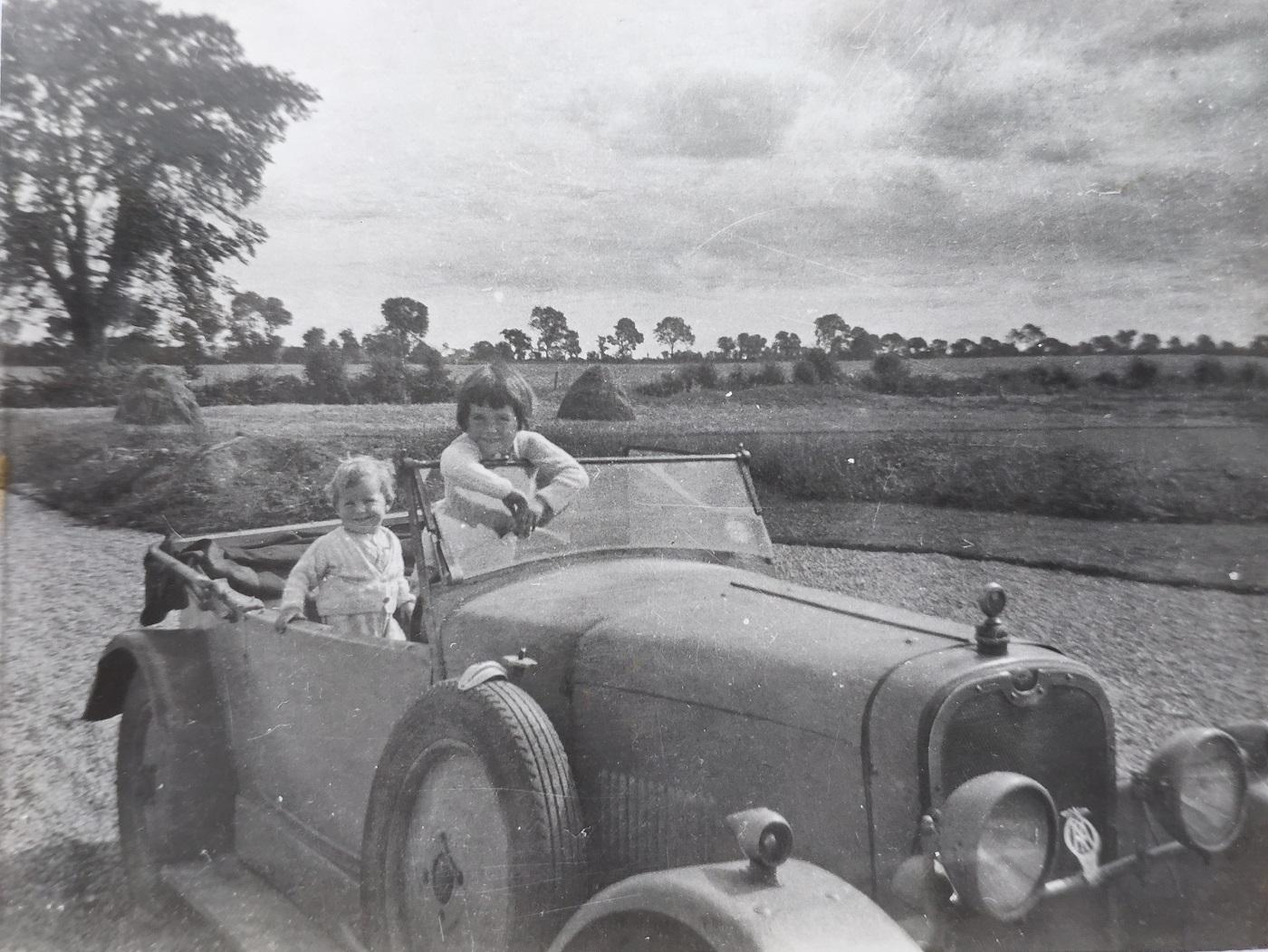
Thomond no.4.
Kingswood, 1935-1936.
David (born 1933) and Eoige.
See
larger
and
full size.
See
other scan.
Four Thomonds or more?


Dick Humphreys in
1963 article is a bit ambiguous
about how many Thomonds were made, and which were his.
He says his Thomond lasted from 1929 to 1933, which we can see is true from its registration.
But he
ignores the Thomond he had after 1933. Again we can see its (different) registration in the records.
He also says there are 4 Thomonds. Is he counting his own Thomond as one or two cars?
Dick says 4 Thomonds
Dick Humphreys in
1963 article
says there were 4 Thomonds.
What does he mean?
-
If he counts both of his as basically one Thomond, then we have a missing car.
This might explain some of the inconsistent descriptions we have of
Thomond no.3
and Thomond no.4.
However then Parsons had to build 5 bodies, which Dick should really mention.
-
If we take Dick's second Thomond as the 4th Thomond, then they are all accounted for.
And Parsons had to build 4 bodies, as he says.
I go with this as the likely theory, but more evidence might emerge.
Other people say more than 4 Thomonds
Jim Barr
thought there were many Thomonds, including a number of saloons.
Henry Barlee
thought he saw an
article with a list of 8-11 Thomonds.
John Wilkinson
said:
"I am fairly sure Harry Barlee said something like 'about a dozen'".
Specification
Thomond no.4 was basically Thomond no.2 with a totally
new body
on top of most of the same mechanicals (except for a new engine).
- New body (including windows, fuel tank, boot, lights, mudguards).
- 2 door, 3 seater touring coupe.
- Undoubtedly retained the small rear seat of no.2.
(This was one of Dick's favourite ideas, and he wouldn't have abandoned it.)
- [Motor Reg]
says colours were initially red and black.
- Repainted again by 1935.
-
Eibhlín
remembered it as bright red,
which she said was
"a quite uncommon colour
- most cars were black".
- Brand new engine.
[Motor Reg]
says engine is 1933.
12 hp tax rating.
- John Wilkinson
said it was another
Meadows 4ED engine.
He thought it was one carb.
- Henry Barlee
said his engine was a 12/40 one carb Meadows 4ED.
- This engine would be 4 cylinders in line, ohv, 1496 cc,
69 x 100 mm,
12 hp for tax, 40 bhp at 4000 rpm.
- Less powerful than Thomond no.2, and much less exciting performance.
- Thomond no.4 seems to have the same chassis,
4 speed gearbox, 4 wheel brakes,
Dunlop wire wheels with tangential spokes, 5 x 19 in. Dunlop tyres.
-
New number plate ZI 9722.
- Dublin City is ZI 1 to ZI 9999 (Mar 1927 to May 1933).
The visible differences between this car and Thomond no.2 (after modifications)
are as follows:
- Metal body (using skills learnt with Thomond no.3).
- New, rounded bonnet.
- 'Grilled' side of bonnet (for new engine).
- New style radiator with rounded radiator top.
Hard to know if old front end damaged in crash, or if Dick just wanted a change.
- Permanent windscreen.
- Side rear windows added in hood.
- 'Body' of headlights painted.
The old, small sidelamps (mounted on front mudguards) were retained.
- Spare wheel held in cage on RHS of car.
Battery on left-hand side (on running board).
- New shape for boot.
-
The fuel gauge and filler cap are now inside a
lockable boot. You have to open the boot to fill up with petrol.
This was a safer method, preventing those outside from
reading off the amount of fuel or syphoning petrol.
(Key lockable filler caps were not yet in use.)
-
The same layout as no.2 was used, i.e. fuel tank directly below boot.
- New mascot. Upright, globular mascot.
- 'Thomond' written in flowing writing on bootlid,
angled on left hand side.
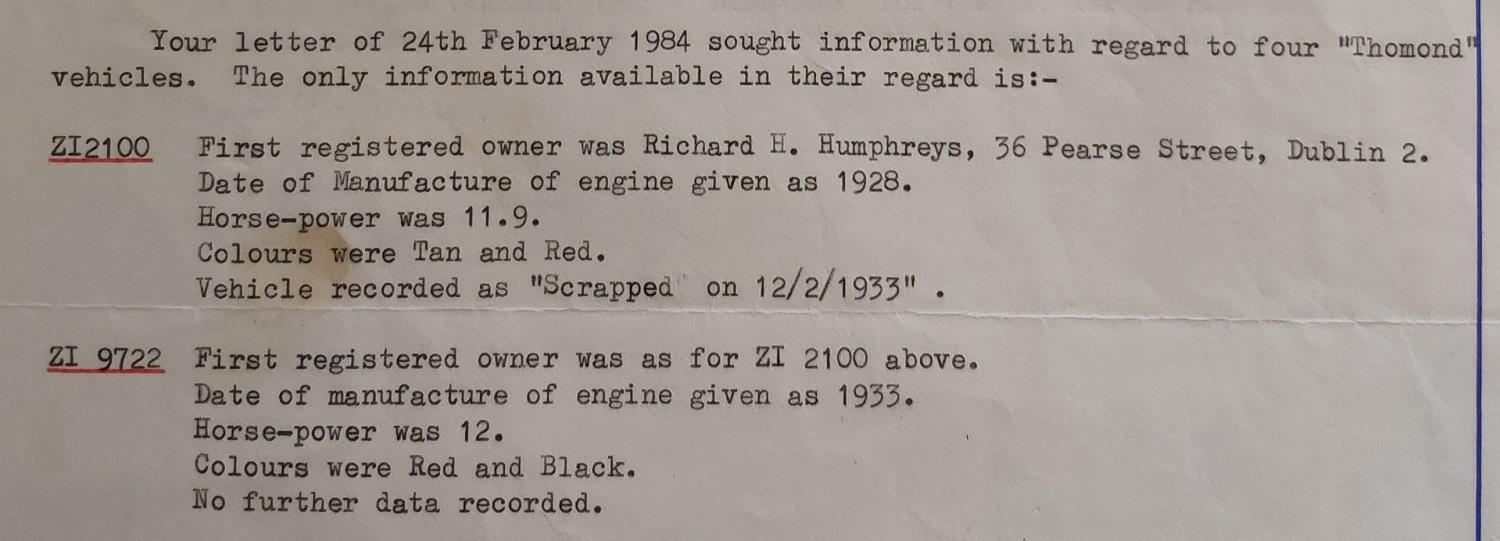
An abstract of the
[Motor Reg]
records for Thomonds no.2 and no.4.
See
full size.
Dick's use of the car
Dick registered the car in early 1933 when he was living
in
Sandymount Park.
In Aug 1933, he moved to
18 Eglinton Park, Donnybrook, Co.Dublin.

Thomond no.4. Still using the old ZI 2100 numberplate.
Eithne, in Co.Galway, around Easter 1933 (April 1933).
Dick tried to use the old ZI 2100 plate,
but with that number officially recorded as 'scrapped'
he had to re-register.
See
larger
and
full size.
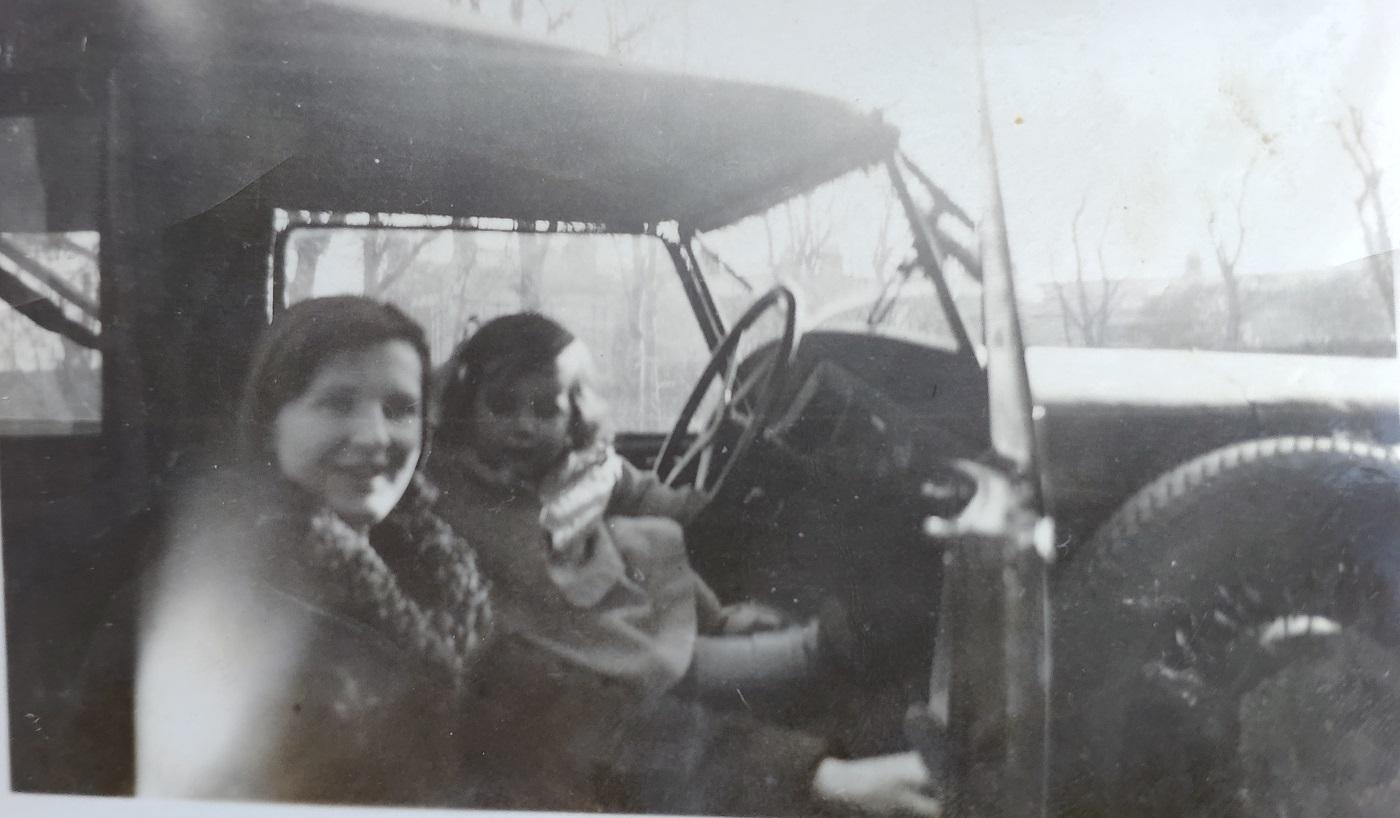
Eithne and Eoige (born 1930)
in the Thomond, probably 1933.
See larger
and full size.
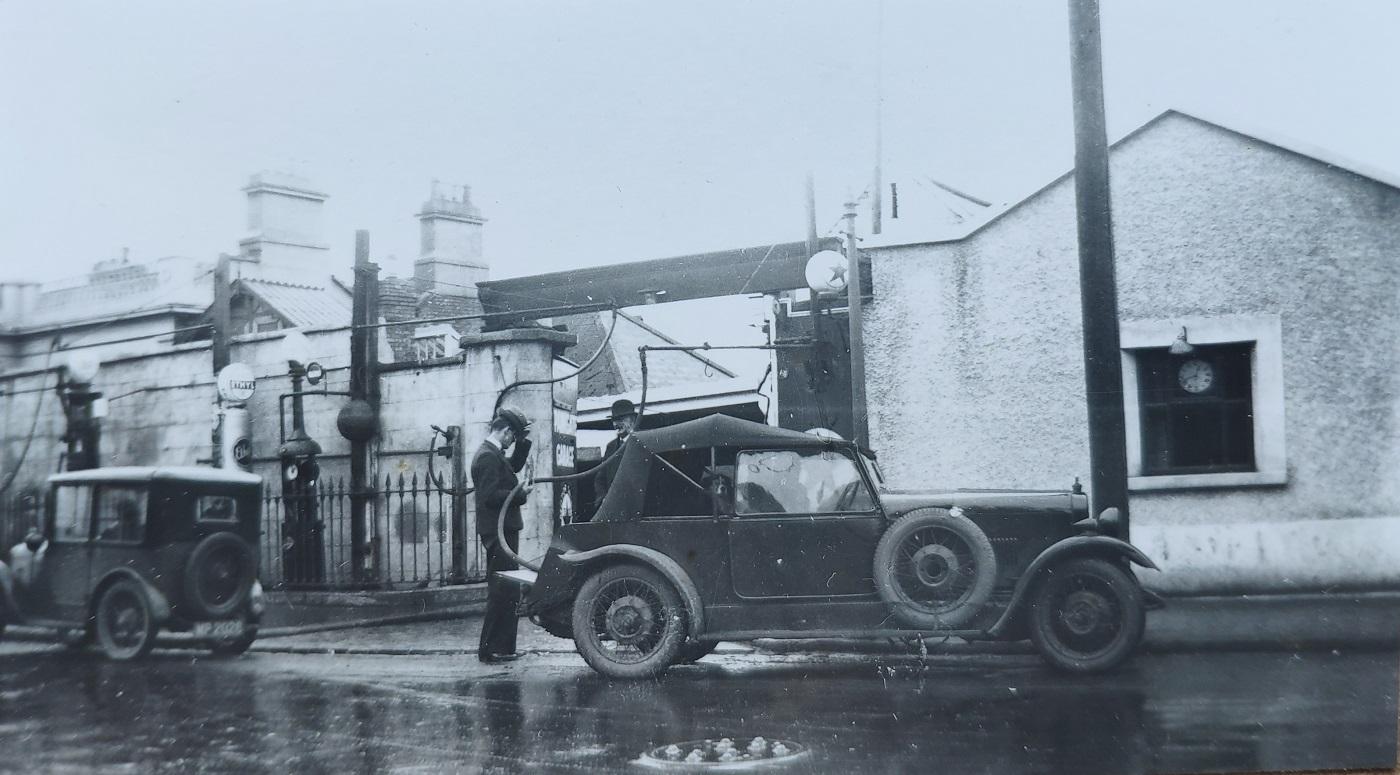
Thomond no.4, at Parkgate Garage, 14a Conyngham Rd, Dublin.
See larger
and full size.
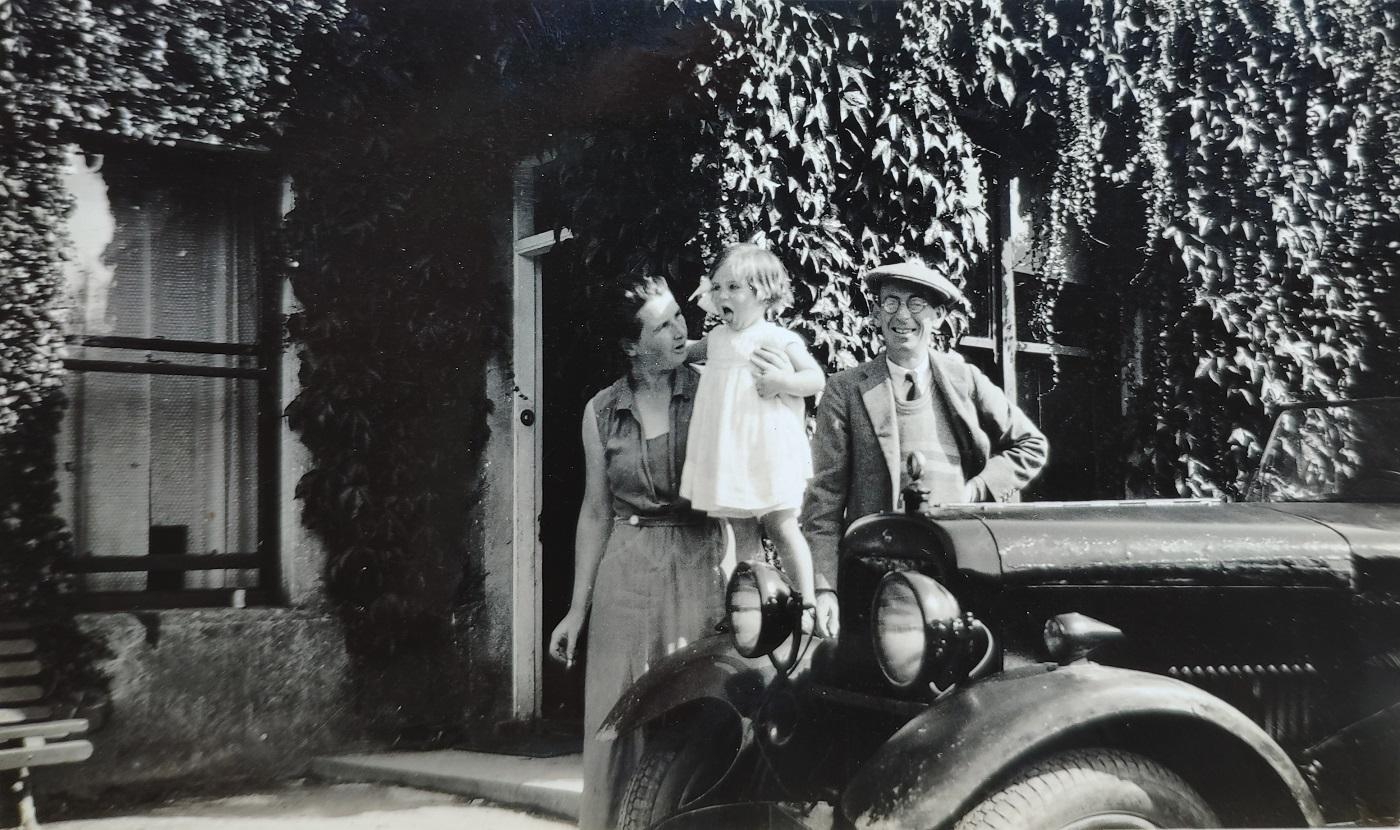
Thomond no.4, at Cashel House.
"1933" written on back.
Maureen
and
Eoige (born 1930)
and Dick.
See larger
and full size.
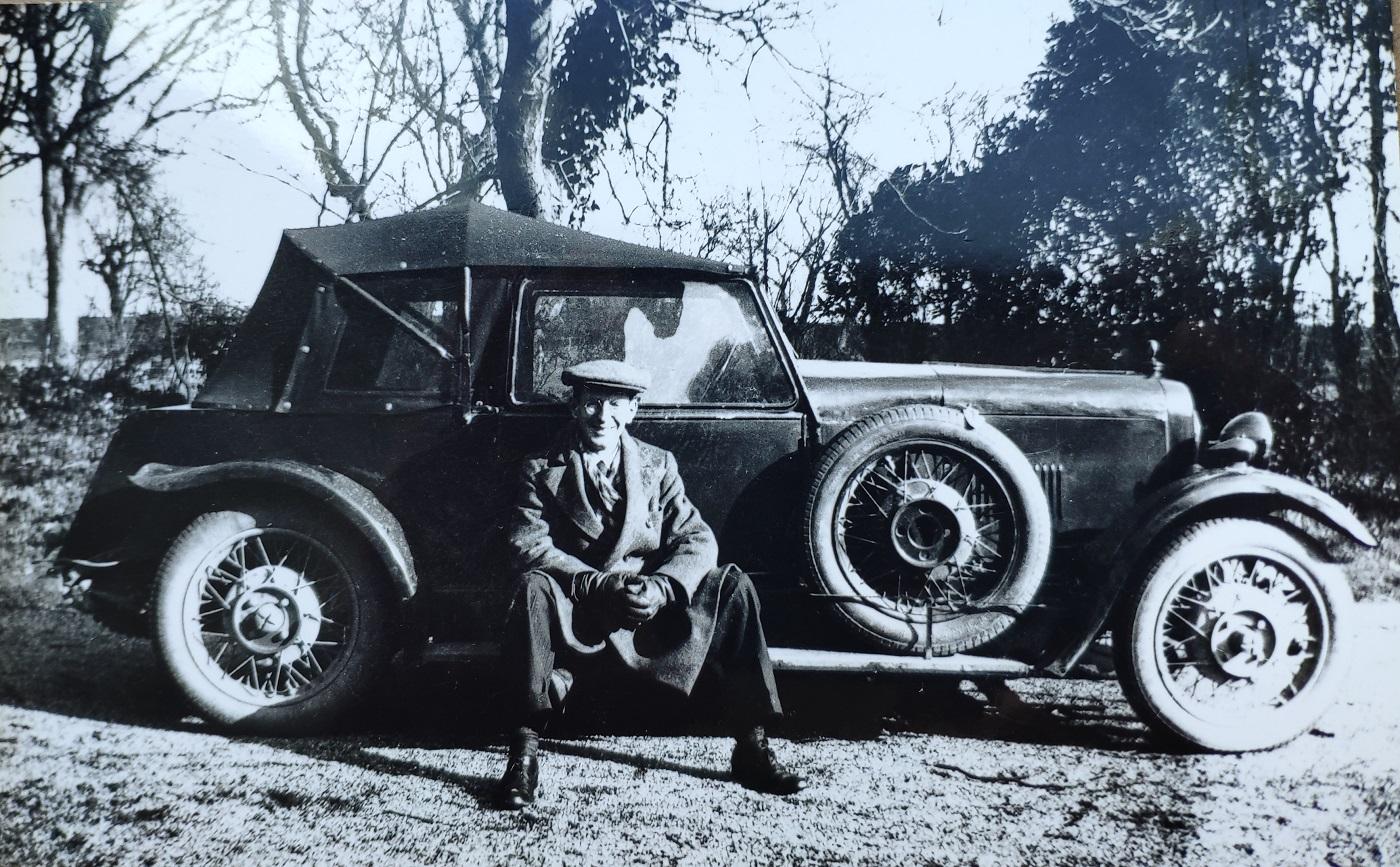
Thomond no.4.
With Dick.
At Sandymount (before Aug 1933).
See larger
and full size.
See
other copy from
[P106/591(2)].
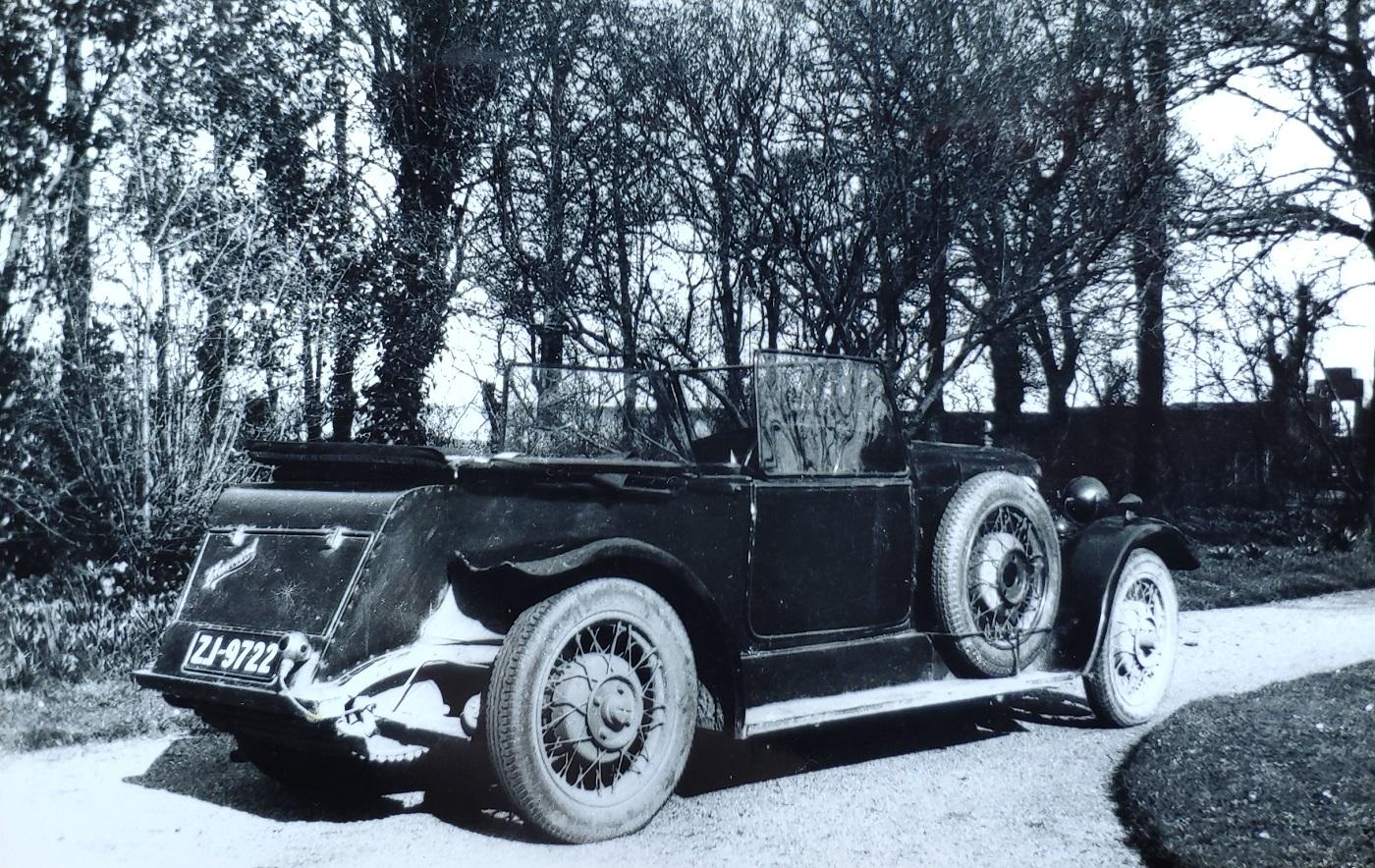
Thomond no.4.
ZI 9722 plate. Thomond logo on back.
See larger
and full size.
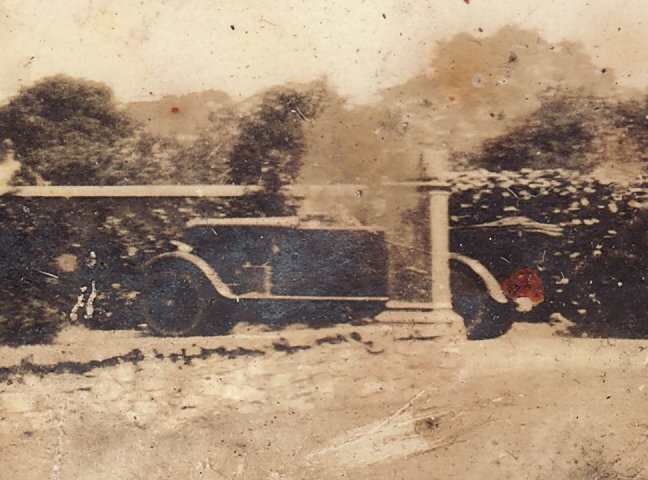
A car at Dick's mother's house,
36 Ailesbury Rd.
Detail of this picture.
Looks rather like no.4.
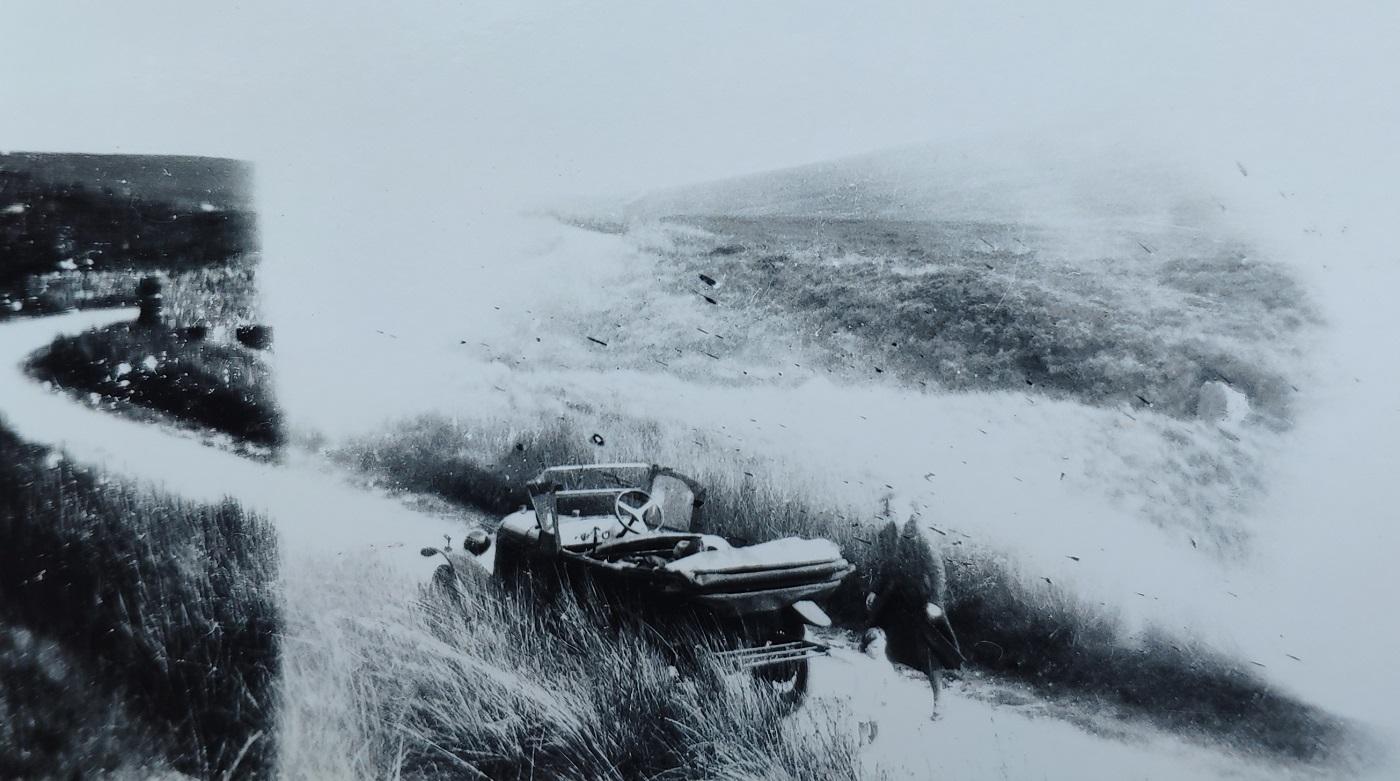
Eithne and Eoige, in Connemara.
Modification: Dick seems to have done away with the boot,
instead storing luggage in the area behind the main seats,
and attaching a small rack to the car below where the boot used to be.
See larger
and full size.
Move to Kingswood, 1935
In about Feb 1935,
Dick and Eithne
moved to their newly built home at
Kingswood, Clondalkin, Co.Dublin.
He still had his Thomond when they moved to Kingswood, where it shows up in photos.
In the photos in Kingswood, we see further modifications:
- Clearly a new paint job.
- Longer rear mudguards.
- Disc wheels at the rear and for spare.
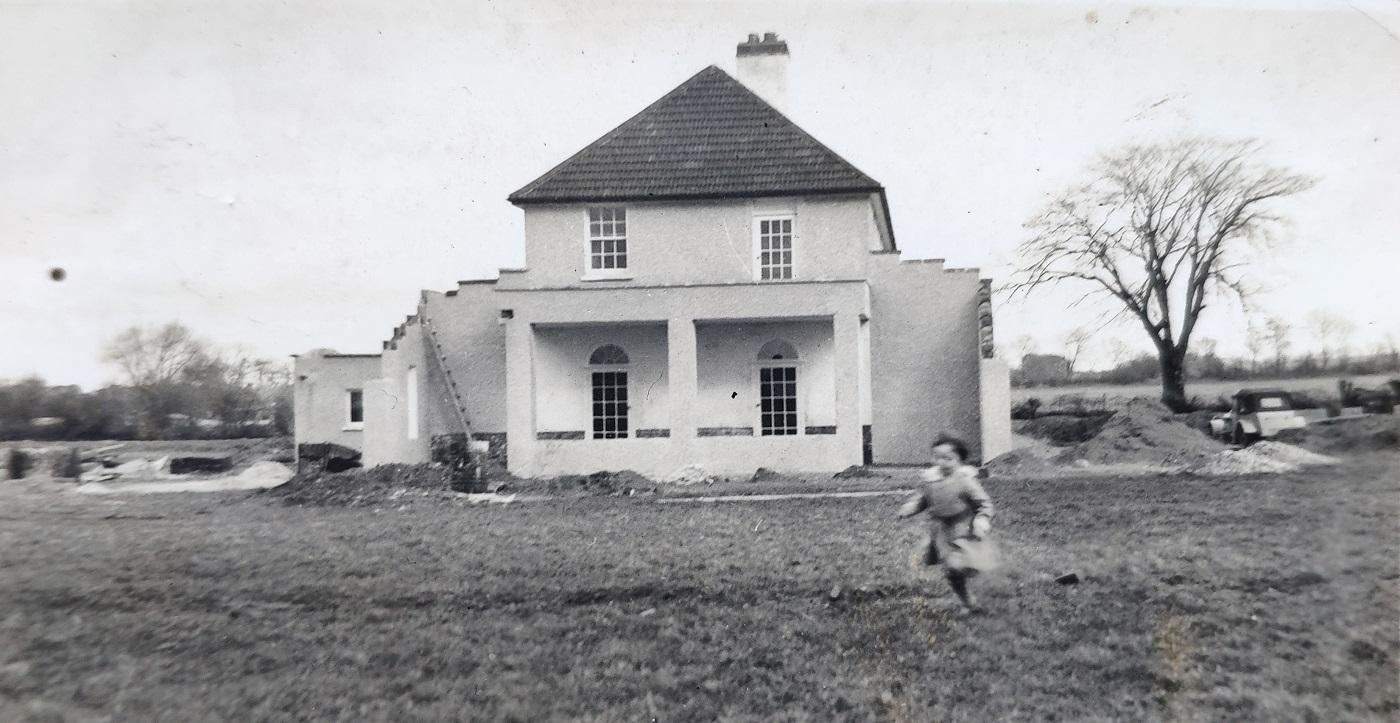
Thomond no.4.
Kingswood, under construction, in 1934-1935.
Eoige (born 1930) running.
See
larger
and
full size.
See
other scan.
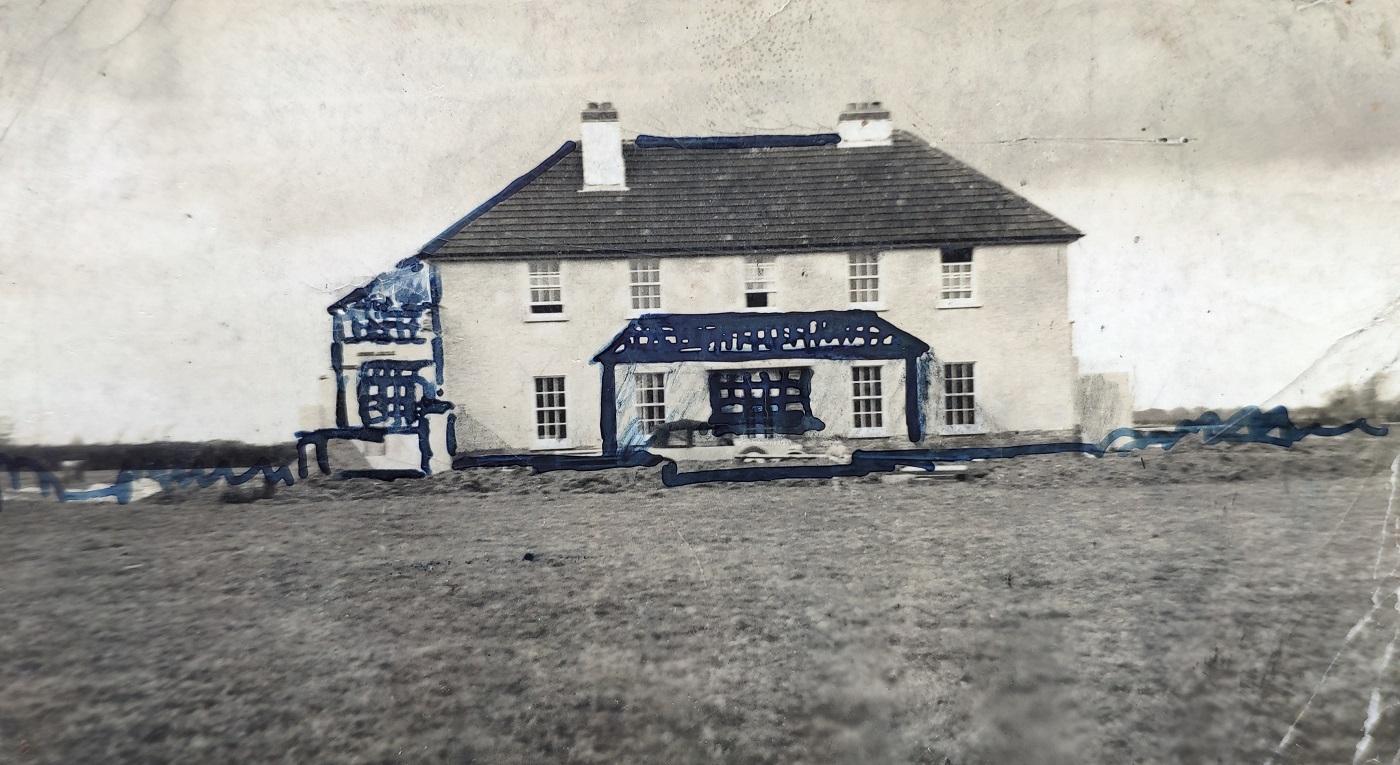
Thomond no.4 at Kingswood, 1935.
See larger
and full size.
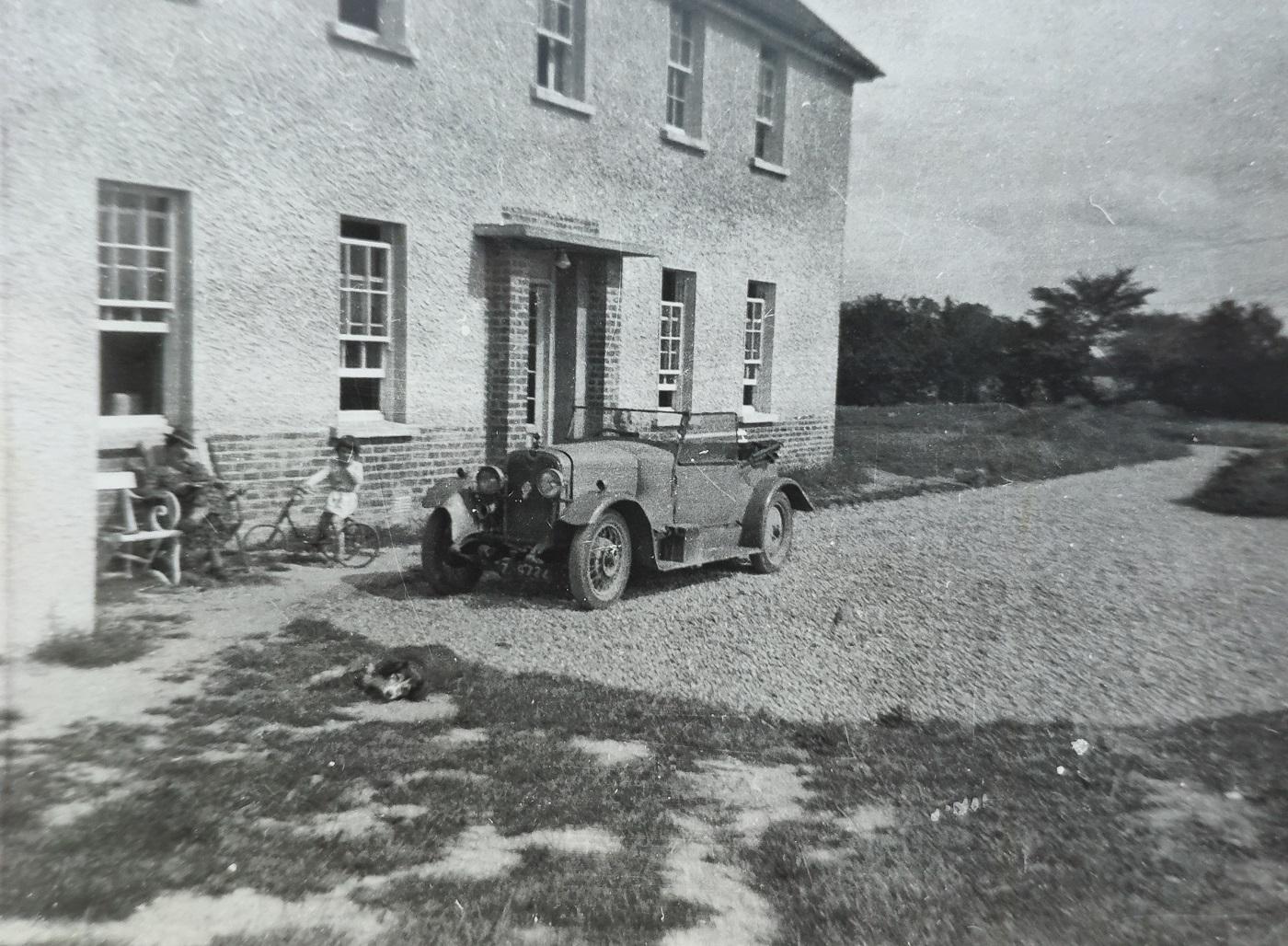
Thomond no.4.
Number plate ZI 9722.
Kingswood, 1935-1936.
Eithne
and her children Eoige and David.
See larger
and full size.
See other scan.
Dick sells it
The re-built Thomond never performed as well as the original one.
It became rather unreliable, and Dick eventually sold it and bought
a regular car.
Eibhlín
remembered
one Thomond, in the 1932-1933 period. It was
bright red.
It was very difficult to get into, with lots of gadgets
sprouting up under the dashboard and up from the floor. She says you might as well
have stepped over the door as have opened it. Dick was always doing things to his cars
- repainting them and changing things around.
She remembers the Thomond as being there until around 1935/1936.
So it seems Dick
sold it around 1935/1936.
It appears in some photos of 1935-1936, which must be just before it was sold.
His wife Eithne thought the car went back
to Jones to be auctioned.

Dick Humphreys' house,
"Ardsolus", Kingswood, Co.Dublin.
From
OS map. Revised 1937. Published c.1958.
It is a shame Dick did not feel more sentimental about the Thomond
and hang on to it. There was plenty of storage space in out-buildings in Kingswood
where it could have passed the years, awaiting the inevitable
modern-day restoration.
Offered to John Wilkinson, around 1937
Around 1937 the Thomond, by now fitted with a
dickey-seat,
was offered for sale to
John Wilkinson,
who did not
eventually buy it.
He said:
"I tried it. I can't remember why
I didn't buy it, probably liked my DISS Delage better!"
John Wilkinson described the car as:
- An open 2 seater.
A metal body, wire wheels.
-
No trunk or tank at the back,
but rather a dickey-seat behind the hood, and possibly the spare wheel there also.
- A radiator with a
rounded top.
-
The bodyline was quite high, and the appearance of the car overall
was not so much sporty as good-looking.
- Similar to a 1929 Lea Francis.
- The bodywork, he felt, must have been from a professional coachbuilders.
(But maybe Ben Parsons had just gotten really good, now on his 4th body.)
-
He said the car was "quite well finished and no feeling of a 'lash-up'".
He felt the car to be of 1930-1931 vintage.
- He saw the
Thomond letterhead photo
and described that car (no.2) as
"a very ugly example,
Barlee's was much prettier".
- He confirms it had a Meadows 4ED engine,
which he described as: "a bit agricultural to work at,
these engines were very reliable".
- He said the performance of the car
was "much like a Leaf, not astonishing but adequate".
- He recalled 4.5 x 19 in tyres on
KO [Knock-Off] Rudge wheels.
4 wheel brakes. The gearbox was 3 speed and reverse.
It had 12 volt lighting (12 volt C.A.V. dynamo) and coil ignition.
- He remembers no mascot,
and 'Thomond' in script on the radiator.
Wilkinson and Barlee's memories clash:
-
Wilkinson said it was
Henry Barlee
who offered it to him.
-
But Barlee did not recall that.
-
Barlee owned a Thomond (see below) but it was a few years later,
and it had a V8 body, and a gas plant.
Not at all like the car Wilkinson describes here.
-
The car Wilkinson describes here sounds more or less like Thomond no.4, with a few modifications.
-
Wilkinson thought it was Barlee though.
He recalled Barlee driving up in the Thomond,
but definitely no V8 body and definitely no gas plant.
-
This clash of memories is unresolved.
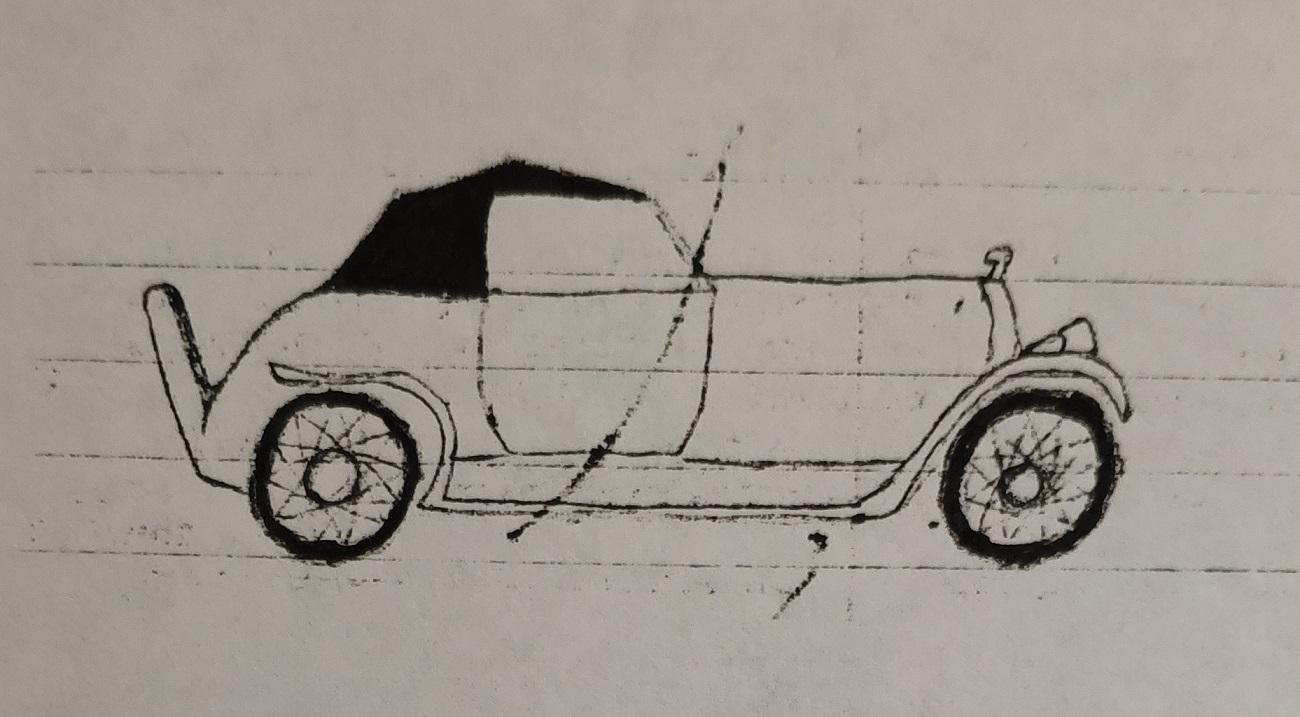
The car offered to John Wilkinson was something like this.
Henry Barlee buys a Thomond, 1940
In 1940,
Henry Barlee (Henry A. Barlee, Harry, born 1912) was
a young solicitor
living at Anne Field, off Taney Rd, Dundrum.
He was a motor enthusiast,
who loved buying and fixing up secondhand and unusual cars.
In 1940, he
bought a Thomond, which he soon crashed and scrapped.
This one is a bit of a mystery because of its body.
The war had started in 1939.
Petrol was rationed.
Half the cars of Ireland went into storage.
Henry
Barlee said that one day in 1940,
he was in Parsons' new garage
when he noticed, in a lock-up shed there,
a Ford V8.
Barlee asked Ben Parsons about it and was told:
"That's not a V8. That's a queer one - a Thomond with a V8 body on it".
At this stage it had lain unused
in the lock-up garage for a couple of years.
Barlee bought it to fix up. He described it as follows:
- Ford V8
body.
- American fixed head 2 door, 2 seater saloon body,
with a dickey-seat.
- He said
quite a crude job had been made of grafting
the V8 body onto the Citroen-like chassis.
-
The 3 speed gearbox from the scrapped V8 was fitted to the Meadows engine.
-
The front of the car was left relatively unchanged, while the V8 body
had a dickey-seat which fitted on well at the rear.
- The colour he remembered as grey or brown, probably brown.
- He said
the car was in a generally poor state. The brakes, steering
and overall build of the car was "very cheap and nasty".
-
When I asked him about the ZI 9722 plate,
this number did ring a bell with him.
But he himself used one number plate, ZA 3283, on about
10 different cars during the war, and the Thomond was one of them.
His friends in the tax office didn't mind.
It does sound from Parsons' reply
like an original Thomond body was removed and a Ford V8 body grafted onto it,
whether by Parsons or someone else.
(The poor work suggests someone else.)
It ended up with Parsons who would have built the original.
Maybe it was hard to sell, with the war,
and Parsons was the only one interested in giving something for his old creation.
But which Thomond is it?
There are sightings of the saloon car, no.3, long after this, and in any case that was a large 4 door, 5 seater.
If there are just four Thomond cars, this seems like it must be no.4 with a new body.
So who put the Ford V8 body on it?

A 1932 Ford V8. 2 door coupe.
Might be similar to the body on Barlee's car.
You can see how this body could fit onto Thomond no.4.
From
here.
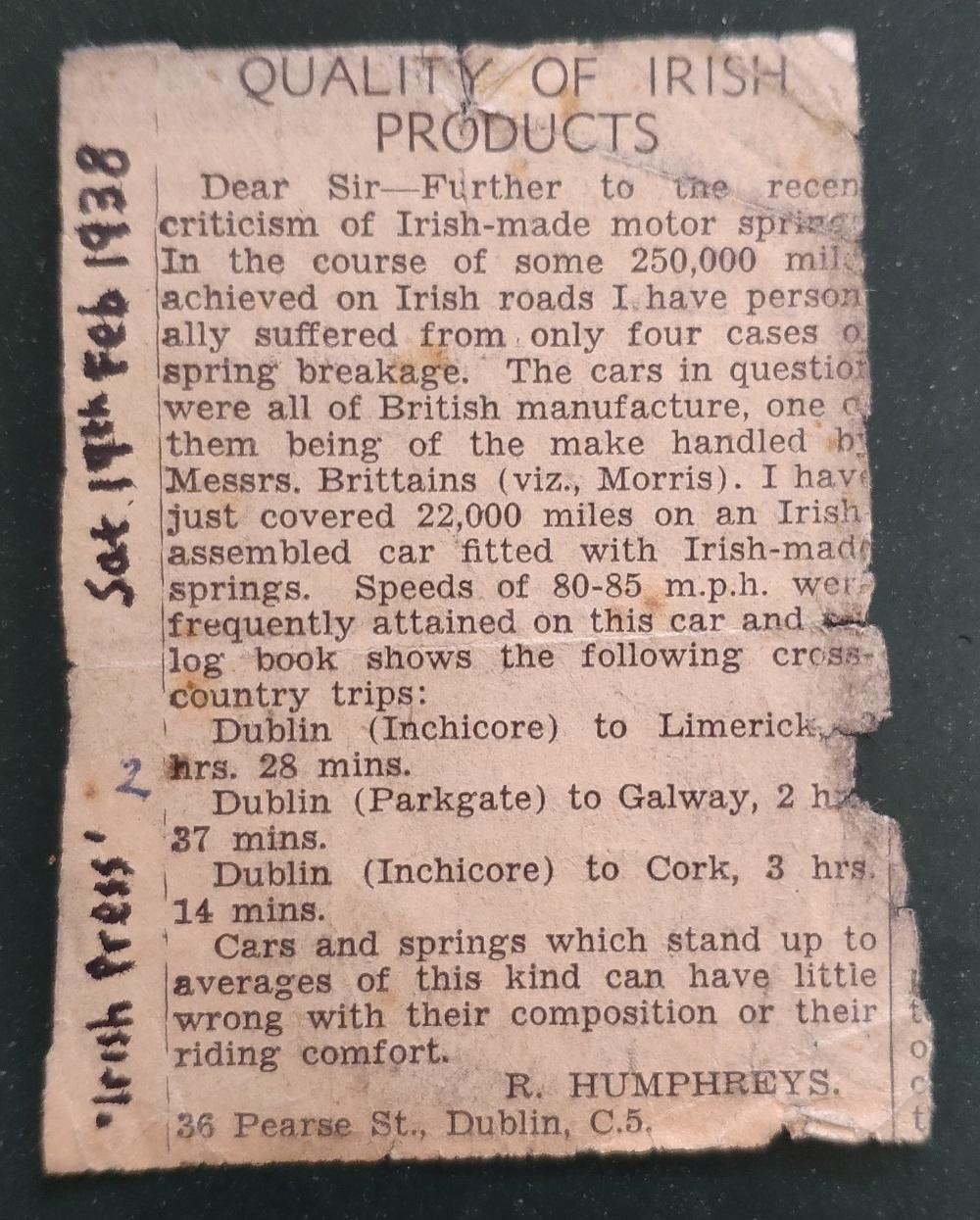
Letter from Dick Humphreys, Irish Press, 19 Feb 1938.
He refers to an "Irish assembled car"
in which he has just covered 22,000 miles, at speeds up to 80-85 mph.
See full size.
- Could this be Thomond no.4?
It would be surprising if he still had no.4 in 1938.
Even if he did, could he have only covered a mere 22,000 miles over 5 years?
And the speeds are too high for that car.
- Most likely this is a Ford, assembled in Cork.
- In fact, Dick in his 1962 letter lists his cars,
including a few Fords,
and also including a Ford V8.
-
Most likely the 1938 letter refers to his Ford V8.
- Could Dick's Ford V8 be the origin of Barlee's Ford V8 body?
Could Dick have grafted his Ford V8 body onto his Thomond?
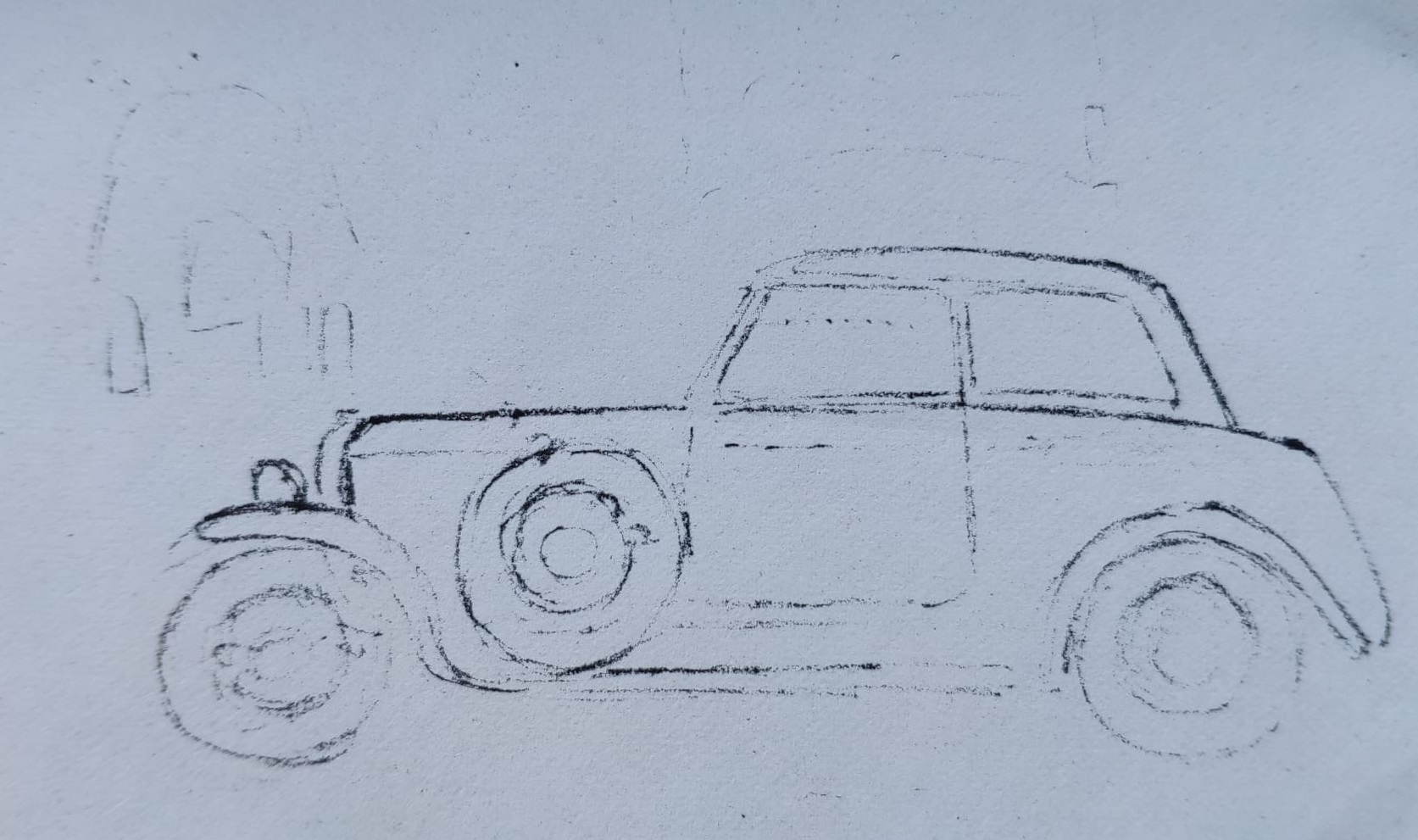
Interestingly, Dick did a sketch of a 2 door saloon.
This is on the back of a photo of Thomond no.4.
See
full size.
- It may not mean anything, since he was always sketching planned designs and ideas.
-
See another sketch of a 2 door saloon.
This is
on the back of a photo of Thomond no.2.

Anne Field, off
Taney Rd, Dundrum, on
1887 to 1913 map.
Henry Barlee was living at Anne Field around 1940.
He is listed at "Annefield, Dundrum" in the people index on p.1667 of
[Thom's, 1939].
But in the house index on p.1579
the occupant is:
"Mrs. Lynton Hunt, Annefield".
Maybe he was in lodgings.
Henry Barlee modifies the Thomond, crashes, scraps it, 1940
Petrol was rationed during the war, and motor enthusiasts found it very hard going.
Barlee decided to try to use a
gas converter,
but he needed
a suitable vehicle to fit it to.
So when he came across Parsons' unused Thomond in 1940,
it was just what he was looking for. A gas plant would fit
in the space of the dickey-seat, so he bought the car, rescuing it
from its rather neglected state.
Barlee got his gas plant, fitted it, and got the car running.
On gas there was nothing great in the way of speed - a cruising speed
of 40-45 mph, and 50 mph the absolute maximum.
Within only a week or so of getting the Thomond running on gas, he crashed it.
He took the car on
a fishing trip with a few friends to the River Slaney.
They were coming through Templeogue
when the "cheap and nasty" steering broke, and the car smashed into
Templeogue Bridge.
The heavy weight of
the gas plant at the back must have upset the steering
and made the car tail-happy.
Buying and fixing up cheap second-hand cars was always a risky business.
John Wilkinson
recalled:
"Harry crashed a good many cars I think - we all did at about £5 or £10 a time."
Bryan Boydell
said that Barlee loved buying very rare and unusual cars,
and, after a few months of ill treatment, selling them.
Cars he owned included a Bugatti
and a Thomond.
He never kept a car for more than a couple of months,
and his poor treatment of them was frowned upon by the more serious enthusiasts.
The Thomond was damaged beyond repair, and Barlee sent it to be scrapped.
This would be 1940.

Templeogue Bridge on
1887 to 1913 map.
The Meadows engine survives?
According to Henry Barlee, one part of the Thomond survived.
He said that the Meadows engine from the Thomond
was bought by his friend,
the motorsport enthusiast
Dudley Colley.
Colley fitted it
in his 1934
Frazer Nash
'Chain Gang'.
-
Colley had bought the Frazer Nash in 1937, and used it for motor sport.
-
In it he won the Cork National Motor Handicap
race
at the 1938 Cork Grand Prix.
(The Handicap race was a separate race to the Grand Prix.)
-
His old engine blew during a race in 1939.
-
He bought a new engine during the war.
[Colley, 1951, p.156]
says:
"When things were at their worst I had come across a Meadows engine
in a Dublin scrap-yard, and having bought it at scrap price
I had unhurriedly reconditioned it and placed it in the chassis".
-
According to Barlee, it was from the Thomond.
- However, in
[Colley, 1951, p.163]
he says his engine in 1948 is now 20 years old (1928).
Whereas the no.4 engine was 1933.
- So the whole story is uncertain.
Colley went through a number of Meadows engines.
He kept all his engines, even blown ones, and he kept records
of engine numbers.
So we might be able to prove this story,
if we can get the engine number of Thomond no.4.
All of Colley's known Meadows engine numbers are:
- 9143
- 9794
- 9985
- 10376
- 10529
- 10559/10569 (illegible)
The next step is to find the engine number of Thomond no.4.

Dudley Colley's memoirs
[Colley, 1951].
Republished 2003.
From
here.
Photo shows Colley's Frazer Nash in 1938 Cork Grand Prix (handicap event).
No mention of Thomond in the book.






















